Everest, Lobuche & Island Peak Climbing Expedition: Experience the ultimate adventure in the heart of the Himalayas with the Everest Base Camp, Lobuche East, and Island Peak climbing expedition offered by Alpine Club of Himalaya. This thrilling 23-day journey is a perfect blend of trekking and mountaineering, taking you through the rugged and breathtaking trails of the Khumbu region to summit two iconic peaks: Lobuche East (6119m) and Island Peak (6165m). As you trek through picturesque Sherpa villages, encounter vibrant local cultures, and witness the awe-inspiring Himalayan peaks, you’ll be treated to spectacular panoramic views of Mount Everest, Lhotse, Makalu, and other majestic summits.
The expedition includes an unforgettable visit to the Everest Base Camp, where you’ll stand at the foot of the world’s highest peak. From the bustling streets of Namche Bazaar to the serene beauty of the high-altitude landscapes, this expedition offers both adventure and cultural immersion. Perfect for experienced trekkers and mountaineers, it’s a once-in-a-lifetime opportunity to experience the Himalayas like never before. Whether you’re seeking to challenge yourself with technical climbs or simply want to explore one of the world’s most iconic trekking routes, this adventure is designed to push your limits and provide memories that will last a lifetime.
Highest Access:
The journey takes you to an impressive altitude of 6165 meters (20,226 feet) at the summit of Island Peak, making it an ideal challenge for climbers who want to experience high-altitude expeditions.
Duration:
18 days of trekking and climbing, designed to give you ample time for acclimatization and preparation for the summits of Lobuche East and Island Peak.
Location:
The Khumbu region, Nepal, located in the shadow of Mount Everest.
Grade:
Peu Difficile + (PD+), making it a moderately challenging trip suitable for climbers with prior high-altitude experience.
Best Seasons:
Spring (April – May) and Autumn (October – November) are the best times to undertake this expedition when the weather is most favorable for trekking and climbing.
Best Season for Trekking and Climbing
The best seasons for trekking and climbing in the Khumbu region—including Everest Base Camp, Lobuche East, and Island Peak—are Spring (April to May) and Autumn (October to November). These periods offer optimal weather conditions for mountaineering and trekking, making them the most popular times for adventurers to undertake their Himalayan expeditions.
Spring (April – May):
- Weather: Spring in the Khumbu region brings warmer temperatures, clear skies, and moderate winds. It’s one of the best times to trek and climb, as the weather is relatively stable and conducive for mountaineering.
- Views: The views of snow-capped peaks like Mount Everest, Lhotse, Makalu, and Pumori are spectacular during this time.
- Crowds: Although popular, Spring is not as crowded as Autumn, providing a more serene experience while trekking through the Everest region.
- Wildlife & Flora: The region starts to come alive with blooming rhododendrons and lush greenery, offering an added visual appeal to the landscapes.
Autumn (October – November):
- Weather: Autumn is another prime season for trekking and climbing. The weather is stable, with clear skies and crisp air. The temperatures are cooler compared to Spring, but still manageable for most climbers and trekkers.
- Visibility: The skies are particularly clear during this period, providing some of the best views of the Himalayan range.
- Crowds: Autumn is slightly busier, as it’s considered peak trekking season. However, it still offers a vibrant yet not overly crowded atmosphere, especially at key locations like Namche Bazaar and Everest Base Camp.
- Climbing Conditions: Autumn’s cold but stable weather provides excellent conditions for climbing Lobuche East and Island Peak, making it the perfect time for mountaineers.
Both Spring and Autumn provide the ideal weather for trekking and summiting, allowing trekkers and climbers to enjoy the best of the Himalayas in terms of visibility, stability, and comfort. However, it’s always important to be prepared for high-altitude conditions, and to choose a season that best suits your climbing experience and goals.
Meals
On the Everest Base Camp, Lobuche East, and Island Peak Climbing expedition with Alpine Club of Himalaya, meals are an essential part of the journey. The meals provided are designed to keep you energized and healthy throughout the trek and climb. In Kathmandu, a Bed and Breakfast (B/B) plan is included, while during the trek and climb, you’ll enjoy a mix of Breakfast, Lunch, and Dinner.
During the trek, you’ll dine in local teahouses and lodges that serve nutritious, calorie-rich meals to sustain you at high altitudes. The food consists of traditional Nepali dishes, such as dal bhat, tibetan bread, and momochas, along with international options like pasta, noodles, rice dishes, and soups. At higher altitudes, the meals are often tailored to be easily digestible and packed with energy-boosting ingredients, helping to support your body’s needs during strenuous activities. Vegetarian and non-vegetarian options are available, ensuring that all dietary preferences are catered for. Special dietary requirements can be accommodated on request.
Drinking Water
Staying hydrated is crucial for high-altitude treks and climbs, especially in the Everest region. During the Everest Base Camp, Lobuche East, and Island Peak climb, Alpine Club of Himalaya ensures that you have access to safe drinking water at all times. While trekking, you will be provided with boiled water or purified water from filters.
At higher altitudes, bottled water may be available, though we encourage climbers to use refillable water bottles and purifiers to minimize environmental impact. Water purification tablets will be provided to all participants to ensure that water from streams and natural sources is safe for consumption. It is recommended to drink plenty of water throughout the day to prevent dehydration and help with acclimatization to the high altitude.
Comprehensive Guiding Services and Equipment
Alpine Club of Himalaya prides itself on offering comprehensive guiding services for your Everest Base Camp, Lobuche East, and Island Peak climbing expedition. Our experienced guides and climbers are well-trained in mountain safety, high-altitude trekking, and technical climbing. They will not only lead you safely through the trails but also provide valuable insights into local culture, flora, and fauna.
In addition to expert guiding, we provide you with all the necessary climbing equipment. This includes ice axes, harnesses, crampons, ropes, and other technical gear required for summiting Lobuche East and Island Peak. We also provide sleeping bags, climbing boots, trekking poles, and high-altitude gear for optimal comfort and safety. All equipment is of the highest quality, ensuring a secure and comfortable journey.
Weather and Climate
The weather and climate in the Khumbu region, especially in areas like Everest Base Camp, Lobuche East, and Island Peak, can vary significantly depending on the season and altitude. The best seasons for trekking and climbing are during Spring (April-May) and Autumn (October-November), when the weather is most stable and the skies are clear. During these months, the temperatures are relatively moderate, making it more comfortable for both trekkers and climbers.
At lower altitudes (around Phakding and Namche Bazaar), the climate is temperate, with daytime temperatures ranging from 10°C to 20°C. As you ascend to higher altitudes, temperatures begin to drop sharply, especially at night. The Everest Base Camp sees temperatures as low as -10°C to -15°C in the evenings. The higher you climb, the colder it becomes, with temperatures plummeting below -20°C on summits like Island Peak and Lobuche East. It’s essential to come prepared with suitable clothing for both warm and freezing conditions.
Weather Challenges
While the seasons of Spring and Autumn provide the most favorable conditions for trekking and climbing, the weather in the Himalayas can still be unpredictable. High-altitude trekking exposes you to extreme conditions, including sudden snowstorms, high winds, and heavy rainfall. The weather can change quickly, especially during the climb to Island Peak and Lobuche East, where snow and ice conditions can make the climb more challenging.
It’s essential to be prepared for extreme temperatures and low visibility. Altitude sickness is another challenge that climbers face in the high Himalayas, so following proper acclimatization techniques is crucial. With Alpine Club of Himalaya‘s expert guides and preparation, weather-related challenges are mitigated, but flexibility and readiness are key to a successful expedition.
Weather Forecast
Staying informed about the weather is critical when trekking and climbing in the Himalayas. Alpine Club of Himalaya closely monitors local weather forecasts throughout the expedition to ensure the safety and well-being of participants. Our guides use real-time weather updates and high-altitude forecasts to adjust the itinerary, if necessary, and to anticipate any adverse conditions.
Weather forecasting in remote mountain regions can be difficult, but we work with trusted local sources to get the most accurate forecasts. In case of unforeseen weather changes, such as snowstorms or high winds, our guides will adjust the route or provide an alternate plan to ensure safety without compromising your adventure.
Environment
The Khumbu region, where Everest Base Camp, Lobuche East, and Island Peak are located, is a stunning and sensitive natural environment. The region is home to unique flora and fauna, high-altitude glaciers, and pristine landscapes. As trekkers and climbers, it’s important to respect the fragile environment of the Himalayas.
Alpine Club of Himalaya is committed to sustainable trekking practices. We promote the use of eco-friendly gear and leave no trace principles to minimize our environmental impact. We encourage trekkers to use reusable water bottles, dispose of waste responsibly, and follow local guidelines for conserving the natural beauty of the Everest region.
Difficulty Level
The Everest Base Camp, Lobuche East, and Island Peak climbing expedition is suitable for experienced trekkers and mountaineers. While the trek to Everest Base Camp itself is classified as moderate, climbing Lobuche East and Island Peak requires a higher level of technical skill.
The difficulty level is considered challenging (PD+), as it involves glacier crossing, rock scrambling, and technical climbing at high altitudes. Participants should be in excellent physical condition, with prior trekking experience at altitudes over 4000m. Experience in high-altitude mountaineering is recommended for summiting Lobuche East and Island Peak. Proper acclimatization, as well as following safety protocols, is essential for a successful and safe expedition.
Safety and Security
Safety is a top priority on the Everest Base Camp, Lobuche East, and Island Peak climbing expedition with Alpine Club of Himalaya. Our experienced guides and climbing experts are trained in high-altitude first aid and mountaineering rescue operations to ensure your safety.
We provide comprehensive travel insurance options for all participants, covering emergencies, medical evacuations, and trip cancellations. Our team also carries satellite phones, first-aid kits, and climbing safety equipment to ensure you’re fully supported in case of any issues. Throughout the expedition, our guides monitor participants’ health and well-being closely, helping to mitigate risks such as altitude sickness and ensuring your journey remains safe and enjoyable.
Travel Insurance
Travel insurance is an essential component of any high-altitude trek or climbing expedition, and the Everest Base Camp, Lobuche East, and Island Peak Climbing expedition is no exception. Alpine Club of Himalaya strongly recommends that all participants purchase comprehensive travel insurance before embarking on this journey. Your travel insurance should cover emergency medical evacuation, trip cancellations, medical expenses, and any potential loss of belongings.
Given the remote location of the Khumbu region and the challenging nature of the climbs, having adequate travel insurance offers peace of mind in case of unforeseen situations such as illness, injury, or flight delays. Medical evacuation from high altitudes can be expensive and logistically challenging, so insurance that includes helicopter evacuation from high altitudes (above 4000m) is highly recommended. Ensure that your insurance also covers high-altitude trekking and mountaineering, specifically for activities like climbing Lobuche East and Island Peak.
Passport and Visa
Before you can begin your Everest Base Camp, Lobuche East, and Island Peak Climbing adventure, you must obtain a valid passport and a Nepal tourist visa. The Alpine Club of Himalaya team will provide guidance on the visa application process, but it is your responsibility to ensure that your passport is valid for at least six months beyond your intended stay in Nepal.
To enter Nepal, most foreign nationals require a tourist visa. This can be easily obtained upon arrival at Kathmandu Airport or in advance through the Nepalese embassy or consulate in your country. You will need to fill out an application form and pay the appropriate fee, which is generally valid for 15, 30, or 90 days. Additionally, a Trekking Permit and a Sagarmatha National Park Permit are required for trekking in the Everest region. Alpine Club of Himalaya will assist in obtaining these permits, but it’s crucial to have your passport and visa in order before arrival.
Physical Fitness and Requirements
Climbing Lobuche East and Island Peak and trekking to Everest Base Camp demands a high level of physical fitness. Alpine Club of Himalaya stresses that participants must be in excellent physical condition to handle the demands of the trek and technical climbing. You should have prior experience in trekking at altitudes over 3000 meters, and be prepared for long days of walking, with treks ranging from 4 to 7 hours per day.
It is important to focus on cardiovascular endurance, strength training, and stamina to prepare for the rigorous climbs and altitude conditions. Regular aerobic exercises like running, cycling, and swimming, as well as strength training for core, legs, and arms, will help you build the necessary fitness. You should also practice carrying a backpack to simulate trekking with weight. Working on flexibility and balance will also be advantageous when scrambling over rocks and traversing glaciers during the climb. Alpine Club of Himalaya provides a pre-departure fitness assessment to help you gauge your preparedness and offer personalized advice.
Preparations and Training
Proper preparations and training are key to a successful Everest Base Camp, Lobuche East, and Island Peak climbing expedition. Adequate physical conditioning through endurance exercises, as well as mental preparedness, are necessary for the physical and psychological challenges of high-altitude trekking and mountaineering.
Alpine Club of Himalaya provides a thorough training guide that includes advice on preparing for high-altitude climbs. We recommend at least 3-6 months of training prior to departure, focusing on endurance (e.g., hiking with a loaded pack, long walks), strength (e.g., squats, lunges, core exercises), and flexibility (e.g., yoga or stretching routines). In addition to physical training, familiarizing yourself with climbing techniques, such as ice axe usage, crampon skills, and roper skills, will give you the confidence needed for Lobuche East and Island Peak.
We also suggest practicing trekking at higher altitudes, if possible, to adapt your body to conditions similar to those on the trek. It’s important to consider diet, hydration, and rest to prepare your body for the challenges ahead. We offer guidance on packing, gear requirements, and health protocols to ensure you’re fully prepared for the journey.
Altitude Sickness and the Role of Alpine Club of Himalaya
Altitude sickness, also known as Acute Mountain Sickness (AMS), is a serious concern at high altitudes, especially when trekking above 3000 meters and climbing peaks like Lobuche East and Island Peak. Alpine Club of Himalaya is committed to ensuring that all participants understand the risks of altitude sickness and take the necessary precautions.
The symptoms of AMS include dizziness, headache, nausea, and shortness of breath. Alpine Club of Himalaya‘s experienced guides are trained in first-aid and AMS prevention. They will ensure proper acclimatization and monitor your health throughout the trek. If any symptoms of AMS are detected, our guides will take immediate action, including adjusting the itinerary for further acclimatization, and if necessary, facilitating a descent to lower altitudes. We also carry oxygen and medicines to treat AMS, and our guides are equipped with communication tools to request emergency evacuation if required.
Acclimatization
Acclimatization is the process by which your body adapts to the decreased oxygen levels found at higher altitudes. In the Everest Base Camp, Lobuche East, and Island Peak climbing expedition, Alpine Club of Himalaya incorporates acclimatization days to ensure that you have enough time to adjust to the increasing altitude.
The process is critical for reducing the risk of altitude sickness and ensuring your body can perform optimally. Key acclimatization points along the route are Namche Bazaar, Dingboche, and Chhukung. These strategic rest days allow trekkers to adjust, hike at higher altitudes, and then return to lower altitudes for sleep, which aids in the body’s acclimatization process. Gradual ascent, combined with these acclimatization periods, increases the chances of a successful and safe climb to Lobuche East and Island Peak.
Importance of Acclimatization
The importance of acclimatization cannot be overstated on a high-altitude journey like the Everest Base Camp, Lobuche East, and Island Peak climbing expedition. Without proper acclimatization, trekkers and climbers are at risk of developing Acute Mountain Sickness (AMS), which can lead to serious health complications such as pulmonary edema or cerebral edema.
Proper acclimatization enables the body to adjust to the reduced oxygen levels found at altitudes above 2500 meters. Symptoms of AMS can be mild, such as headache and fatigue, but they can also become severe, including confusion, loss of coordination, and difficulty breathing. Alpine Club of Himalaya prioritizes acclimatization to minimize these risks and ensures climbers stay healthy throughout the journey. Our guides are trained to monitor your health and make necessary adjustments to the itinerary to ensure your safety.
Team Composition
The team composition for the Everest Base Camp, Lobuche East, and Island Peak climbing expedition is designed to ensure a safe and enjoyable experience for all participants. Each team includes a mix of experienced local guides, climbing Sherpas, and support staff.
Our guides are highly trained in mountaineering, high-altitude trekking, and first-aid, ensuring that the group is in expert hands throughout the journey. For climbing sections such as Lobuche East and Island Peak, a climbing Sherpa will accompany you to provide additional technical support, including assistance with rock climbing and glacier traversing. The team is also supported by porters who carry the majority of the equipment, ensuring that climbers can focus on the trek and climbs.
The number of participants in the expedition is typically kept small, with Alpine Club of Himalaya operating with a maximum of 10-12 trekkers per group. This small size allows for personalized attention and ensures the highest levels of safety and communication throughout the expedition.
Facilities and Camp Setup
On the Everest Base Camp, Lobuche East, and Island Peak climbing expedition, Alpine Club of Himalaya ensures the highest standards of comfort and safety. At lower altitudes, we stay in well-established teahouses and lodges that offer basic, but comfortable, facilities such as hot showers, twin-sharing rooms, and hearty meals.
As we ascend to higher altitudes, we set up camps for the Lobuche East and Island Peak climbs. Alpine Club of Himalaya uses high-quality tenting systems with insulated sleeping pads and sleeping bags to ensure warmth and comfort in cold conditions. Base camps are equipped with cooking facilities, toilets, and essential safety gear. Each camp is strategically placed to allow for optimal acclimatization and safe climbing conditions. Our porters and camp crew ensure that the setup is efficient, and that climbers are well-rested for the challenging days ahead.
Lukla Flight and Costs
Flying to Lukla is an essential step for your Ama Dablam expedition, as it serves as the primary gateway to the Everest region. The flight from Kathmandu to Lukla is an exhilarating experience, offering stunning aerial views of the Himalayan mountain range, including peaks like Mount Everest, Lhotse, and Makalu. This short but dramatic flight is not only practical but also an unforgettable part of the journey, setting the tone for the adventure ahead.
Cost
The cost for a one-way flight from Kathmandu to Lukla typically ranges around $215 USD per person. However, this fare can fluctuate based on several factors such as the airline, the time of booking, and peak season demand. It’s always advisable to book your flight in advance to secure the best rates and ensure availability, especially during the peak trekking seasons (Spring and Autumn).
Keep in mind that while this price may seem steep, the experience of flying to Lukla, with its incredible mountain vistas and the excitement of landing at one of the world’s most extreme airports, is invaluable. Plus, the flight is a vital link to the Khumbu region, where your trek and climb will begin.
Operating Airlines
Several reliable airlines operate flights between Kathmandu and Lukla, each with its own services, safety protocols, and schedules. Here are some of the most popular airlines that offer regular flights to Lukla:
- Sita Air: Known for its reliability and experienced pilots, Sita Air operates frequent flights to Lukla, offering a safe and smooth flying experience. The airline is particularly favored by trekkers and climbers due to its familiarity with the challenging terrain of the region.
- Tara Air: Another highly regarded choice for flights to Lukla, Tara Air is well-known for its commitment to safety and excellent customer service. This airline provides consistent service to Lukla with well-trained staff and an excellent safety record.
- Summit Air: Summit Air also operates regular flights to Lukla, catering to the needs of trekkers and climbers. The airline is known for its operational efficiency and the comfort it provides on short, high-altitude flights.
- Yeti Airlines: With a strong track record in domestic air travel, Yeti Airlines also provides reliable service to Lukla. It is recognized for offering a comfortable and safe travel experience to the region.
Flight Duration and Weather Considerations
The flight duration from Kathmandu to Lukla typically lasts around 30 to 40 minutes, though it can be influenced by factors like air traffic and weather. The views during the flight are breathtaking, giving you a bird’s eye view of some of the world’s highest peaks and lush valleys below. However, weather conditions play a significant role in the operation of flights to Lukla, especially during the monsoon season (June to August) and winter months.
Due to the challenging weather patterns and the unpredictable nature of flights in the Himalayan region, flights to Lukla can sometimes be delayed or canceled. The Lukla airport has a short runway, and flights are often subject to wind conditions, fog, and cloud cover, making flexibility in your travel plans highly recommended.
Tips for Lukla Flights
- Book in advance to ensure your spot, particularly during the high trekking seasons.
- Arrive early at the airport, as the flight schedules are sometimes adjusted due to weather conditions.
- Prepare for delays or cancellations by having a flexible itinerary and allowing a few extra days in Kathmandu or Lukla for possible schedule changes.
- Pack lightly as the airlines have specific weight limits for baggage—usually around 10-12 kg per passenger for checked luggage and 5 kg for carry-on.
Overall, flying into Lukla is not only a practical necessity but also a scenic and exhilarating experience, giving you a unique perspective on the majestic mountains you are about to explore on foot.
Essential Equipment and Gear List
Preparing for an Everest expedition requires a comprehensive list of gear to ensure safety, comfort, and success. Below is a detailed list of essential equipment categorized by type:
- Moisture-wicking thermal tops and bottoms
- Long-sleeve shirts
- Fleece or down jackets
- Insulated pants
- Waterproof and windproof shell jacket
- Waterproof and breathable pants
- Warm hat (beanie)
- Balaclava or face mask
- Sun hat or cap
- Liner gloves
- Insulated gloves or mittens
- Waterproof mountaineering boots (double or single)
- Lightweight trekking shoes
- Gaiters
- Moisture-wicking socks (several pairs)
- Thick wool socks
- Comfortable climbing harness
- Climbing helmet for protection
- Dynamic ropes (for climbing)
- Static ropes (for fixed lines)
- Carabiners Locking and non-locking carabiners (various sizes)
- Ice Axes
- Crampons compatible with your boots
- Snow bars and Ice screws for securing and belaying
- Sleeping and Camping Equipment
- Sleeping bag rated for extreme cold temperatures (down or synthetic)
- Insulated sleeping pad for comfort
- High-altitude expedition tent (provided by the expedition)
- Backpack
- Large trekking backpack (60-80 liters)
- Daypack for shorter hikes
- Biodegradable soap
- Toothbrush and toothpaste
- Wet wipes or hand sanitizer
- First Aid Kit Include personal medications, band-aids, antiseptic wipes, etc.
- High SPF sunscreen and UV-protective lip balm
- Polarized sunglasses, high UV protection sunglasses
- Insulated water bottle or hydration bladder
- GPS Device or Map Navigation tools for trekking
- Headlamp With extra batteries
- Satellite Phone For communication (if not provided by the expedition)
- Power Bank For charging devices
- Camera For capturing memories (with extra batteries)
- Adjustable trekking poles for stability
- Energy bars, gels, or other high-calorie snacks
- Massage Ball or Foam Roller For muscle recovery
Booking Policy
To confirm your booking the following payment policy applies:
Deposit at Booking: A 20% deposit of the total trek amount is required at the time of booking to secure your spot.
Remaining Balance: The remaining 80% of the total trek cost can be paid upon your arrival in Kathmandu before the trek begins.
Credit Card Payments: If you prefer to pay the remaining amount via credit card, please note that a 4% service charge will be applied by the bank to the total amount.
Final Notes
Ensure that all your gear is tested and comfortable before the expedition. Proper fit and functionality are crucial for high-altitude climbing. Some gear may be provided by the expedition team, so check with them regarding specific items included in your package.
Cancellations Policy
In the event of cancellations, the following policies will apply:
Cancellation by the Participant:
- If a participant decides to cancel their trip, they must notify the Alpine Club of Himalaya as soon as possible.
- Cancellations made 60 days or more before the trip will incur a fee of 20% of the total cost.
- Cancellations made between 30 to 59 days before the trip will incur a fee of 50% of the total cost.
- Cancellations made less than 30 days prior to departure will result in a forfeiture of the entire payment.
Cancellation by the Organizer:
If the Alpine Club of Himalaya cancels the expedition due to unforeseen circumstances, such as extreme weather conditions, natural disasters, or safety concerns, participants will receive a full refund or the option to reschedule for a later date.
Force Majeure:
The Alpine Club of Himalaya is not liable for any additional costs incurred due to cancellations resulting from force majeure events (e.g., natural disasters, political unrest, or health emergencies).
Insurance:
It is highly recommended that participants obtain travel insurance that covers trip cancellations, interruptions, and medical emergencies to safeguard against potential financial loss.
Participants are encouraged to read the cancellation policy carefully and consider purchasing travel insurance to protect their investment in this once-in-a-lifetime adventure.
Trip Highlights
- Stand at the foot of the world’s highest peak, Mount Everest.
- Climb Lobuche East (6119m) and Island Peak (6165m) for an exhilarating mountaineering experience.
- Enjoy panoramic views of Everest, Lhotse, Makalu, Ama Dablam, and other Himalayan giants.
- Acclimatize at Namche Bazaar, Dingboche, and Chhukung for optimal high-altitude performance.
- Experience the vibrant culture of Sherpa villages, including a visit to Tyangboche Monastery and Hillary Museum in Namche Bazaar.
- Traverse glaciers and engage in technical rock climbing during the Lobuche East and Island Peak ascents.
- Trek through beautiful landscapes, including Khumbu Glacier, Imja Valley, and the picturesque Khumbu region.
- Witness the stunning sunrise over Everest from Kalapatther (5545m).
- Enjoy local traditions, customs, and cuisine in remote Sherpa villages.
- Conclude the adventure with a traditional Nepali dinner and cultural program in Kathmandu.

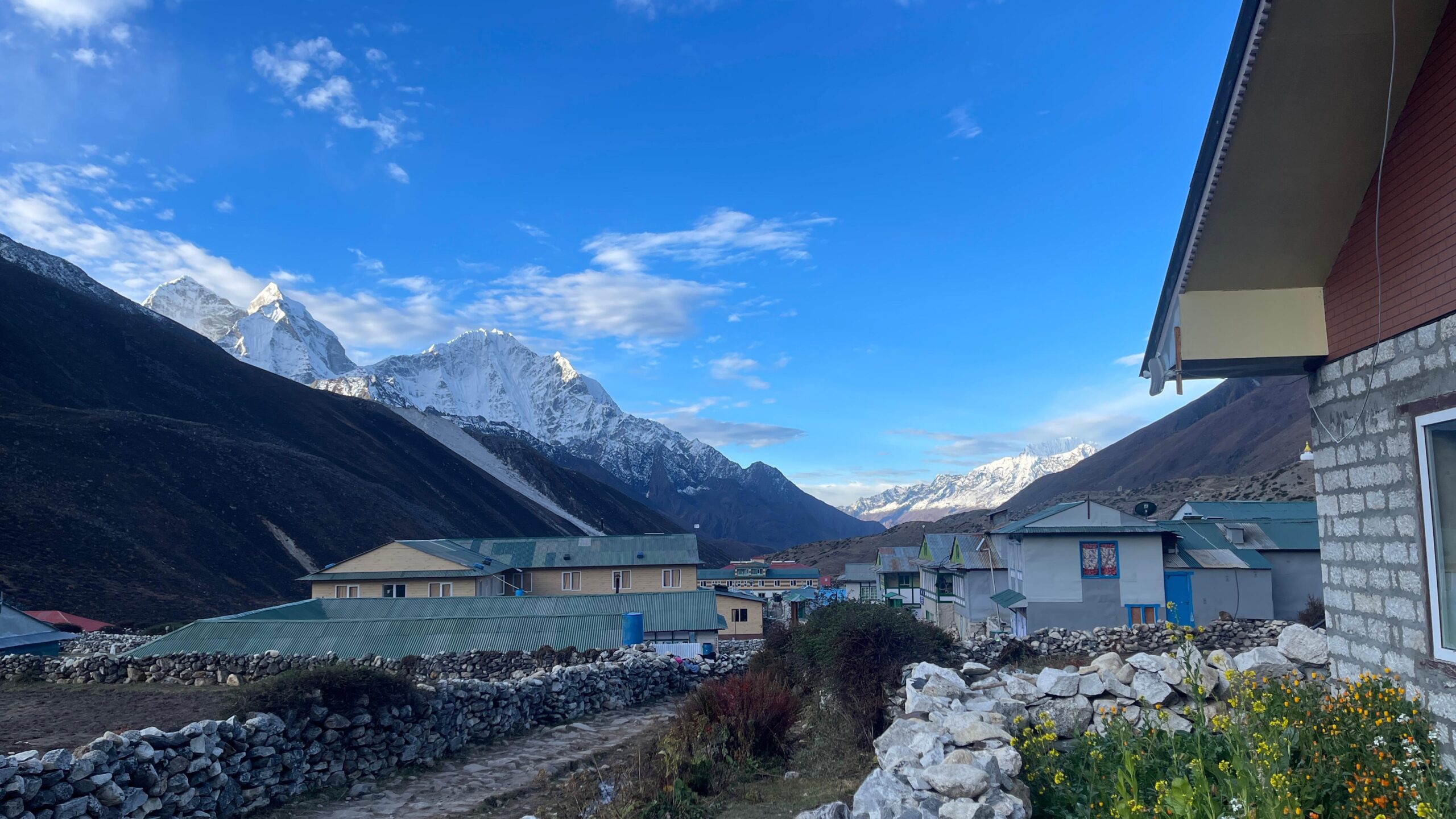







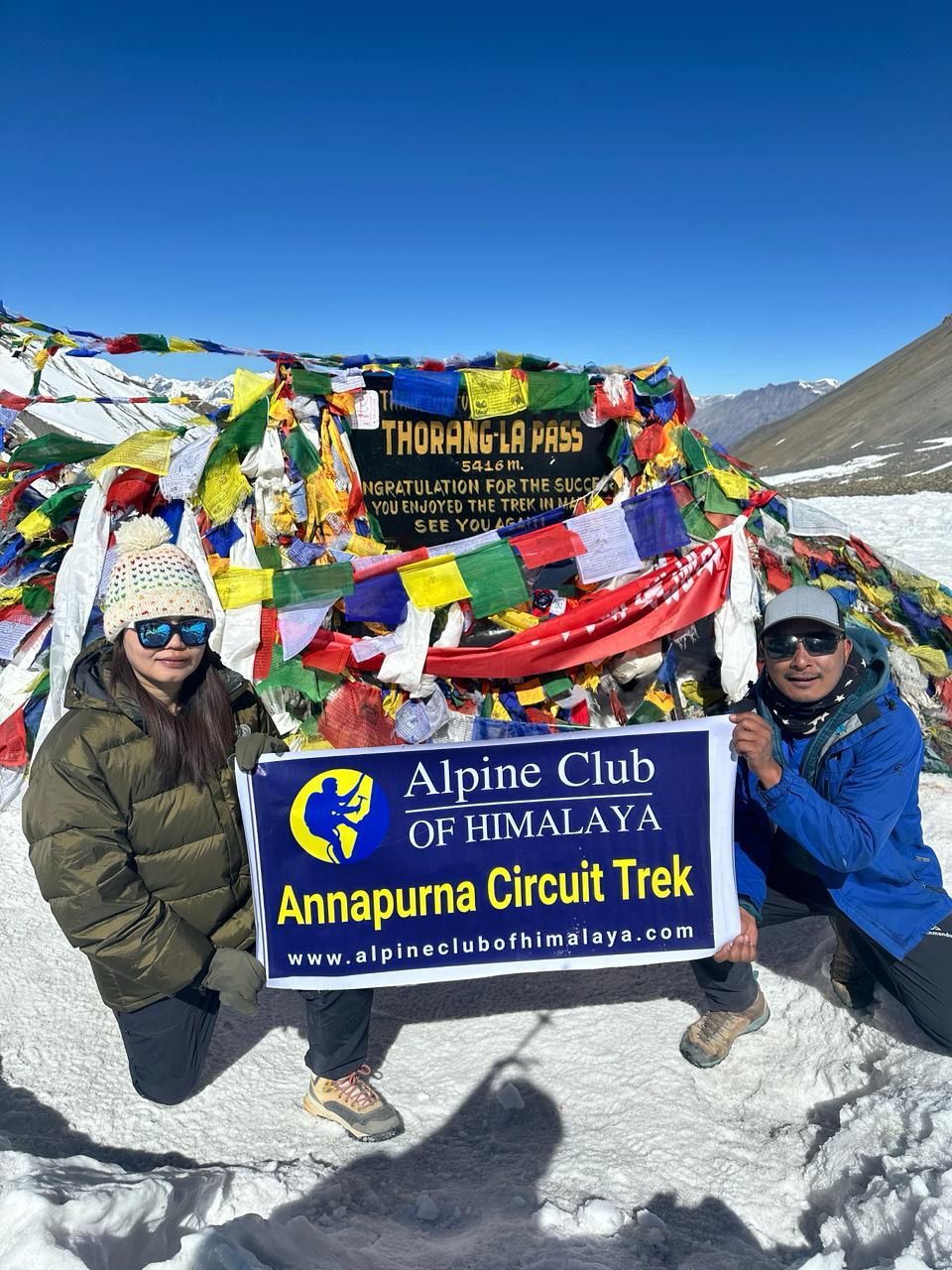
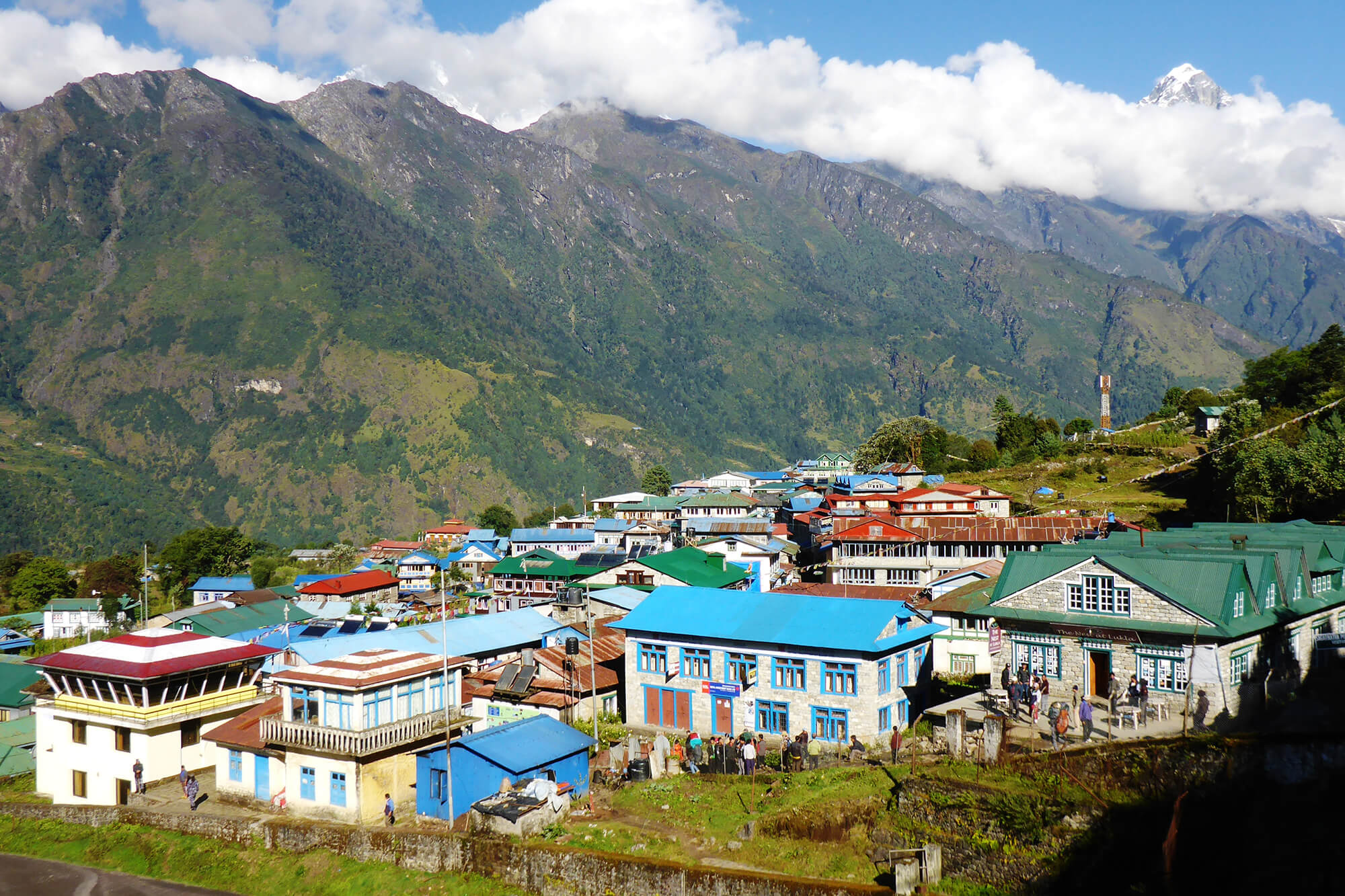
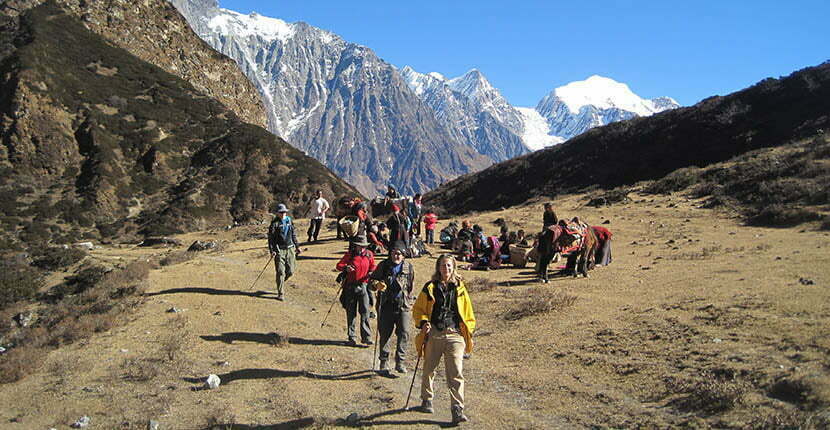
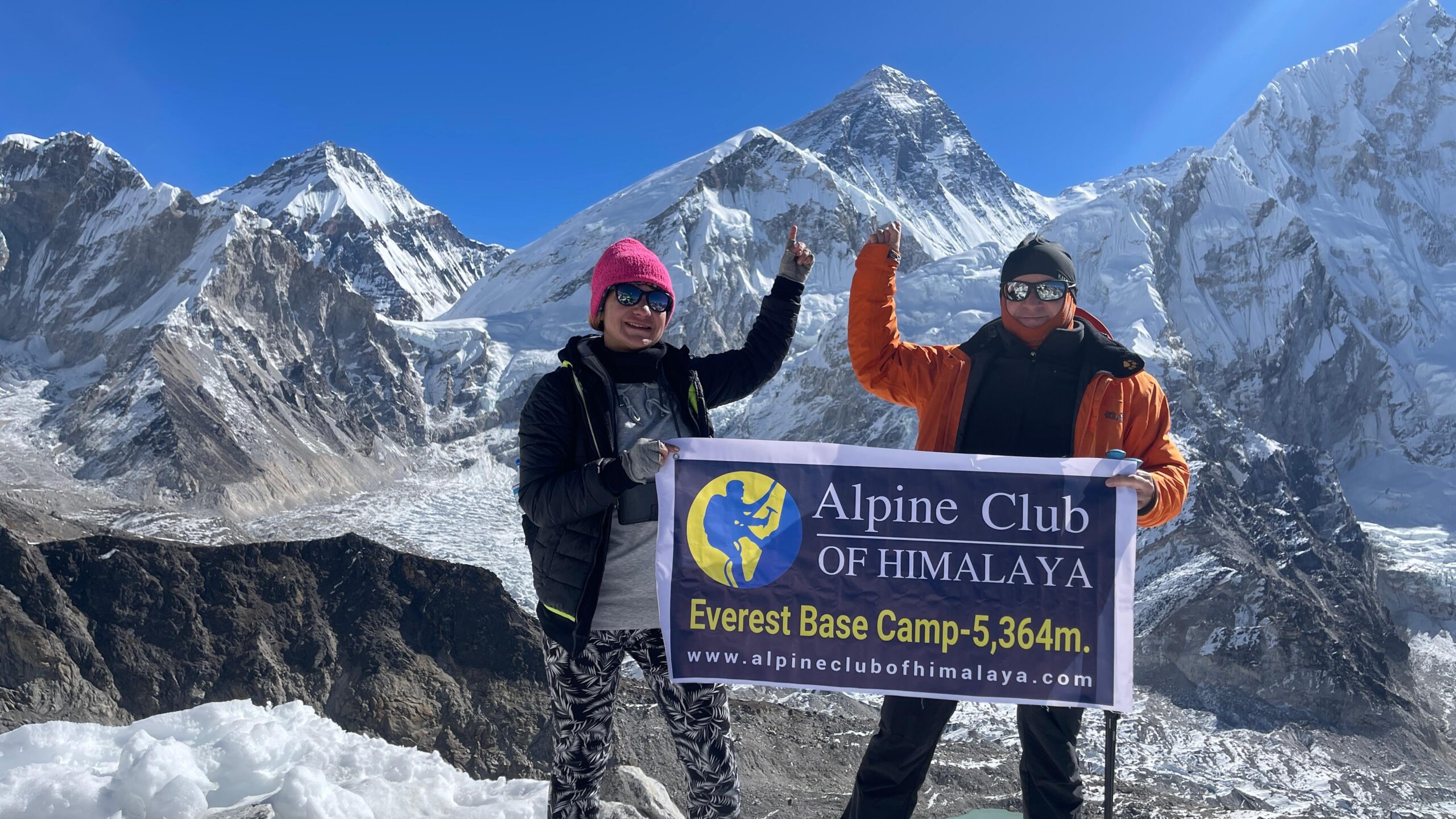
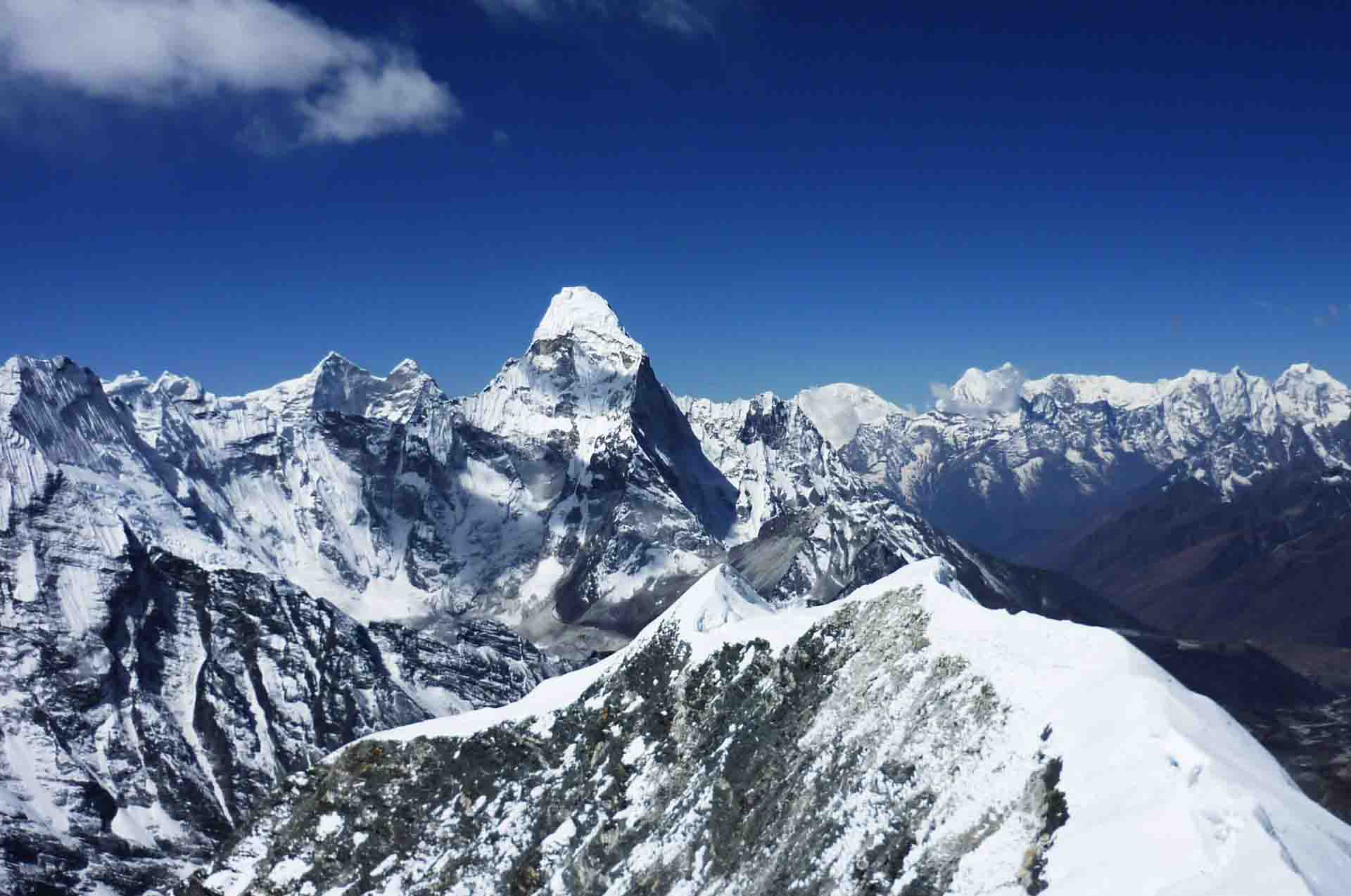
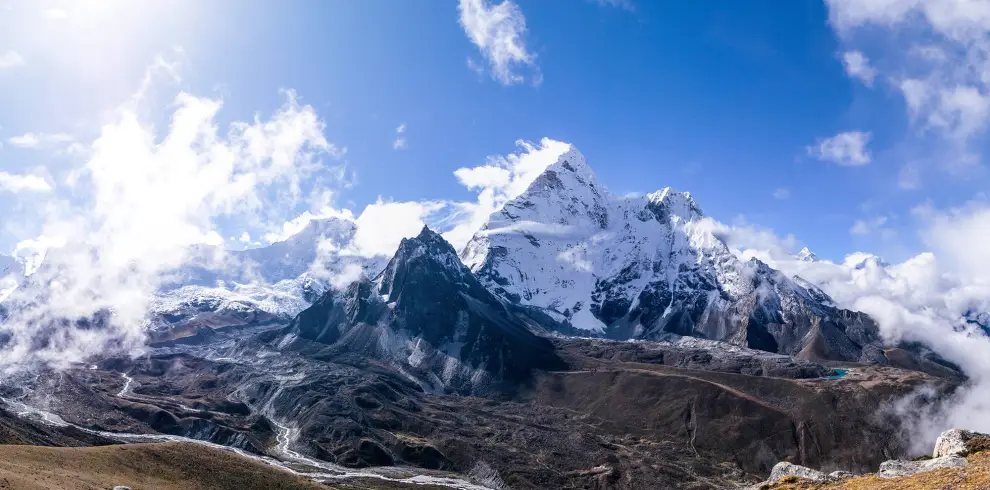
Write a Review